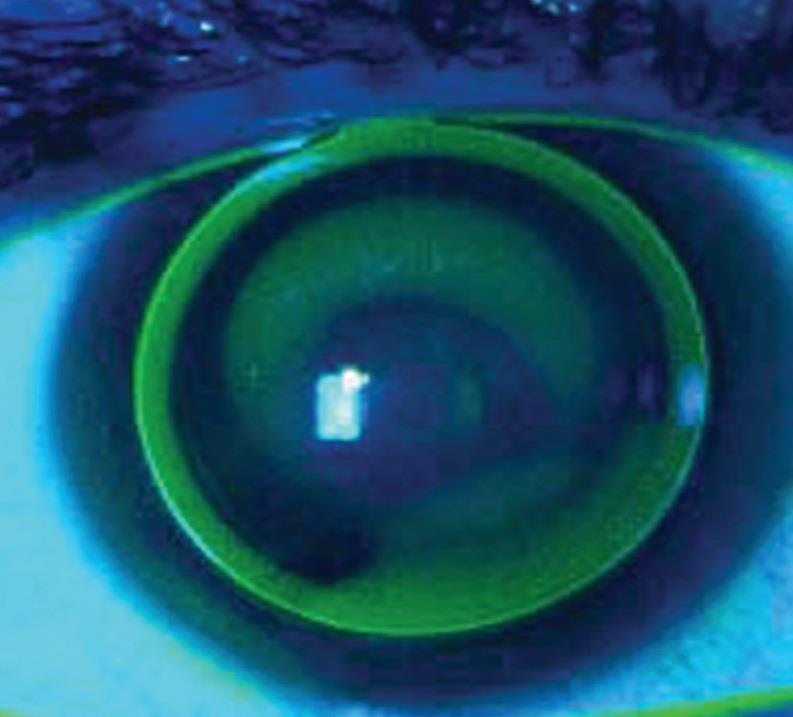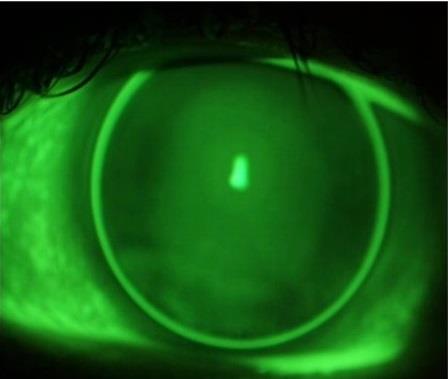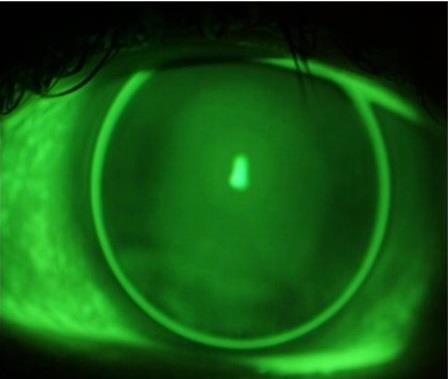
Q1. Which of the following terms best describes the contact lens profile shown in the diagram (figure 1)?
Answer B. The lens diagram shows that there are three back surface curves of different radius and each clearly defined from the other two.
Q2. Which of the following best describes the fit of this RGP lens based on the fluorescein pattern (figure 2)?
Answer A. The central dark area suggests central corneal touch while the peripheral band of fluorescein indicates significant elevation of the edge of the lens from the ocular surface.
 Figure 2
Figure 2
Q3. Which of the following best describes the fit of this RGP lens based on the fluorescein pattern?
Answer C. The opposite of the previous pattern, here there is a large area of central pooling of fluorescein and minimal fluorescein around the edge indicating a steep fit.
 Figure 3
Figure 3
Q4. Which of the following best describes the lens shown here?
Answer A. With the rise in popularity of soft simultaneous multifocal lenses, this rigid lens design, which mimics the appearance of a flat top D-seg bifocal spectacle lens relies upon the downgaze adopted when reading causing the seg to move in front of the pupil. It is therefore described as an alternating lens, shown here positioned for distance viewing.

Q5. This is the everted lid of a monthly replacement silicone hydrogel lens wearer at a 12 month aftercare (figure 3). He finds his lenses less comfortable (described as ‘foreign body sensation’) and has reduced wearing time. Acuity seems variable after blinking. Which of the following statements is false?
Answer C. This grade 2 papillary response can result from a hypersensitivity, allergic response as a result of mechanical impact, such as might occur with long term wear of a higher modulus lens. The actual patient shown was not a contact lens wearer, but instead was found to have seasonal allergic conjunctivitis.

Q6. Last year, this patient known to have a compromised tear film, but otherwise healthy eyes with stable acuity, was moved out of silicone hydrogel lenses into conventional hydrogels. He has found the new lenses much more comfortable, but now admits to wearing times sometimes approaching 15 hours each day. What is the white arrow pointing to?
Answer C. Both microcysts and striae might offer evidence of a cornea under some degree of hypoxic stress. The improved comfort that is afforded by some modern hydrogel lenses means that it is sometimes warranted to move somebody out of silicone hydrogel to a new lens with a reduced oxygen transmissibility. In such cases, it is essential to regularly check for any earlier signs of hypoxia, ones that might appear well in advance of any limbal neovascularisation. Microcysts look like small bubbles in the epithelium. Striae, as here, are to be found in the stroma.
Q7. This patient reports less clear vision with his latest supply of toric soft lenses. He attends for aftercare having worn the lenses today for around one hour. Which of the following statements is false?
Answer A. Simple observation of the marker at the bottom shows a 10 degree anti-clockwise rotation.
Q8. Which of the following may be deduced from this appearance?
Answer B. The loss of surface reflection suggests a diffuse matt finish on the external surface, so ruling out the endothelial dystrophy. This poor wetting appearance might be contributed to by inadequate cleaning or even excessive wear times, but this deduction could not be confirmed without further information.
Q9. Which of the following statements about this image is false?
Answer D. The distorted reflection of a Placido disc projected image is clearly more marked in the four to five o’clock area of the cornea. It is not an evenly distributed distortion.
The final three questions all referred to figure 4.
Q10. Which of the following can be deduced from the fluorescein pattern?
Answer B. Superior and inferior fluorescein pooling relative to a central horizontal band of touch indicates that the cornea is steepest in the vertical meridian.
Q11. Which of the following is not seen here?
Answer D. There is clearly fluorescence at nine o’clock and in the conjunctival folds. Surface scratches show the lens has had some wear. These are not stained in the way that foreign body tracks might be.
Q12. Which of the following management options is most appropriate?
Answer B. There is no evidence of poor fit. Lens replacement, so offering a clean smooth anterior lens surface, should benefit tear flow and minimise the stain previously mentioned.


